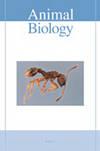蜻蜓翅膀扇动模式对翅膀内部液体循环的驱动机制
IF 0.9
4区 生物学
Q2 ZOOLOGY
引用次数: 4
摘要
会飞的动物可以启发更先进的飞行方式的实用方法。蜻蜓表现出一种特殊的拍打模式,它们的翅膀在拍打时进行扭转运动,这与鸟类不同。这种扑动模式在本文中称为非同步扑动。我们提出了一种假设,即非同步拍打为增强蜻蜓翅膀内的血淋巴循环提供了动力。为了支持这一假设,研究人员设计并使用活蜻蜓进行了一项对照实验。通过对活蜻蜓自由振翅和受限翅内静脉内液体运动的观察,支持了这一假设。建立了扑翼的数学模型,并对其进行了数值研究,进一步支持了非同步扑翼在驱动环流中的作用。本研究为非同步扑动促进血淋巴循环的机理提供了理论解释。本文章由计算机程序翻译,如有差异,请以英文原文为准。
Driving mechanism of dragonfly’s wing flapping pattern for liquid circulation inside wing
Flying animals can inspire practical approaches to a more advanced way of flying. Dragonflies demonstrate a special flapping pattern in which their wings perform torsional movement while flapping, which is different from that of birds. This flapping pattern is referred to as nonsynchronous flapping in this article. We present a hypothesis that nonsynchronous flapping provides a driving force for enhancing the haemolymph circulation inside dragonfly wings. To support this hypothesis, a controlled experiment was designed and conducted with living dragonflies. By observing the liquid motion inside the vein within free flapping wings and restricted wings of living dragonflies, this hypothesis was supported. A mathematical model of the flapping wing was built and numerically studied to further support the function of the nonsynchronous flapping pattern in driving the circulation. With these studies, a theoretical explanation for the mechanism of enhancing the haemolymph circulation by nonsynchronous flapping was provided.
求助全文
通过发布文献求助,成功后即可免费获取论文全文。
去求助
来源期刊

Animal Biology
生物-动物学
CiteScore
2.10
自引率
0.00%
发文量
34
审稿时长
3 months
期刊介绍:
Animal Biology publishes high quality papers and focuses on integration of the various disciplines within the broad field of zoology. These disciplines include behaviour, developmental biology, ecology, endocrinology, evolutionary biology, genomics, morphology, neurobiology, physiology, systematics and theoretical biology. Purely descriptive papers will not be considered for publication.
Animal Biology is the official journal of the Royal Dutch Zoological Society since its foundation in 1872. The journal was initially called Archives Néerlandaises de Zoologie, which was changed in 1952 to Netherlands Journal of Zoology, the current name was established in 2003.
 求助内容:
求助内容: 应助结果提醒方式:
应助结果提醒方式:


